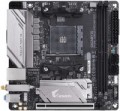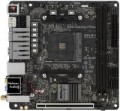Power phases
The number of processor power phases provided on the motherboard.
Very simplistically, phases can be described as electronic blocks of a special design, through which power is supplied to the processor. The task of such blocks is to optimize this power, in particular, to minimize power surges when the load on the processor changes. In general, the more phases, the lower the load on each of them, the more stable the power supply and the more durable the electronics of the board. And the more powerful the CPU and the more cores it has, the more phases it needs; this number increases even more if the processor is planned to be overclocked. For example, for a conventional quad-core chip, only four phases are often enough, and for an overclocked one, at least eight may be needed. It is because of this that powerful processors can have problems when used on inexpensive low-phase motherboards.
Detailed recommendations on choosing the number of phases for specific CPU series and models can be found in special sources (including the documentation for CPU itself). Here we note that with numerous phases on the motherboard (more than 8), some of them can be virtual. To do this, real electronic blocks are supplemented with doublers or even triplers, which, formally, increases the number of phases: for example, 12 claimed phases can represent 6 physical blocks with doublers. However, virtual phases are much inferior to real ones in terms of capabilities — in fact, t...hey are just additions that slightly improve the characteristics of real phases. So, let's say, in our example, it is more correct to speak not about twelve, but only about six (though improved) phases. These nuances must be specified when choosing a motherboard.
Lighting sync
Synchronization technology provided in the board with LED backlight (see above).
Synchronization itself allows you to "match" the backlight of the motherboard with the backlight of other system components — cases, video cards, keyboards, mice, etc. Thanks to this matching, all components can change colour synchronously, turn on / off at the same time, etc. Specific features the operation of such backlighting depends on the synchronization technology used, and, usually, each manufacturer has its own (Mystic Light Sync for MSI, RGB Fusion for Gigabyte, etc.). The compatibility of the components also depends on this: they must all support the same technology. So the easiest way to achieve backlight compatibility is to collect components from the same manufacturer.
Max. clock frequency
The maximum RAM clock speed supported by the motherboard. The actual clock frequency of the installed RAM modules should not exceed this indicator — otherwise, malfunctions are possible, and the capabilities of the “RAM” cannot be used to the fullest.
For modern PCs, a RAM frequency of
1500 – 2000 MHz or
less is considered very low,
2000 – 2500 MHz is modest,
2500 – 3000 MHz is average,
3000 – 3500 MHz is above average, and the most advanced boards can support frequencies of
3500 – 4000 MHz and even
more than 4000 MHz.
XMP
The ability of the motherboard to work with RAM modules that support
XMP (Extreme Memory Profiles) technology. This technology was developed by Intel; it is used in motherboards and RAM blocks and only works if both of these system components are XMP compliant. A similar technology from AMD is called AMP.
The main function of XMP is to facilitate system overclocking (“overclocking”): special overclocking profiles are “sewn” into the memory with this technology, and if desired, the user can only select one of these profiles without resorting to complex configuration procedures. This is not only easier, but also safer: every profile added to the bar is tested for stability.
ECC
The ability of the motherboard to work with memory modules that support
ECC (Error Checking and Correction) technology. This technology allows you to correct minor errors that occur in the process of working with data, and increases the overall reliability of the system; mainly used in servers.
Integrated RAID controller
The presence of a built-in
RAID controller on the motherboard. This function allows you to create RAID arrays from drives connected to the system using only the tools of the motherboard itself, in other words, through the standard BIOS or UEFI (see above), without using additional hardware or software.
RAID is a set (array) of several interconnected drives, perceived by the system as a whole. Depending on the type of RAID, it can provide an increase in read speed or increased reliability of information storage. Here are some of the more popular types:
— RAID 0 — data is written one by one to each of the connected disks (one file may be written to different disks). Provides performance improvements, but not fault tolerance.
— RAID 1 — information written to one of the disks is "mirrored" on all the others. Provides increased reliability by reducing system effective capacity.
— RAID 5 — information is written one by one, as in RAID 0, however, in addition to the main data, the so-called disks are also written to disks. checksums that allow you to restore information in the event of a complete failure of one of the disks. It has good fault tolerance and does not reduce the useful volume of disks as much as RAID 1, however, it is relatively slow and requires a minimum of 3 disks (two are enough for the previous types).
There are other varieties, they are used less often. Different motherb
...oards may support different types of RAID, so before buying a model with this feature, it's ok to check the details separately.Audiochip
The model of the audio chip (a module for processing and outputting sound) installed on the motherboard. Data on the exact name of the sound chip will be useful when looking for detailed information about it.
Modern "motherboards" can be equipped with fairly advanced audio modules, with high sound quality and extensive features, which makes them suitable even for gaming and multimedia PCs (although professional audio work will still most likely require a separate sound card). Here are the most popular modern audio chips:
Realtek ALC887,
Realtek ALC892,
Realtek ALC1150,
Realtek ALC1200,
Realtek ALC1220,
Realtek ALC4050,
Realtek ALC4080,
Supreme FX.
Amplifier
Built-in audio signal amplifier in motherboards with an integrated sound card. Provides higher sound quality through headphones.
Optical S/P-DIF
Output for sound transmission, including multi-channel, in digital form. Such a connection is notable for its complete insensitivity to electrical interference, since an optical cable, rather than an electrical cable, is used to transmit the signal. The main disadvantage of
optical S / P-DIF, in comparison with coaxial, is a certain fragility of the cable — it can be damaged by strongly bending or stepping on it.

